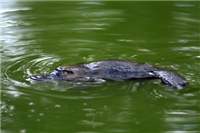Family
OrnithorhynchidaeGenus
Ornithorhynchus
Species
anatinusThreats/Control Methods - Regional
The damming of rivers, irrigation, bank erosion, fish netting, rising salinity and chemical pollution are all having a negative impact on Platypus survival. These factors both take away from the range of food available and impacts upon their habitat.Threats/Control Methods - Local
Water bodies in urban areas are less resilient against periods of droughts or extreme weather events, causing a build-up of toxins and dangerous algae levels, which may impact the health of this species. This species relies on a range of healthy water species for feeding and is therefore impacted if water sources become polluted. Urban waterways are often inappropriate for safe burrowing, as they are easily accessible by humans and predators like Dogs (Canis familiaris) and Foxes (Vulpes vulpes ).
Local/Urban Actions
Joining in the activities hosted by Waterwatch, Landcare or Greening Australia can help to improve habitat areas through increased river vegetation and water quality.
Humans should avoid handling the platypus. In the rare case that a male is provoked to use his venomous spur on a human, the venom is not life threatening. However, spurring is painful and will lead to inflammation of the area around the attack.
Common name/s
Duckbill
Distinguishing Features
This unique species is characterised by its large flat bill, its webbed feet and its furry body and broad tail. Its length ranges from 40-50cm. Its fur is grey-brown, with light patches around the eyes and underparts. The bill is grey and the webbed feet are dark. Males have a small, venomous spur on their hind legs.
Similar Species
This is arguably the most distinct looking creature in Australia.
Distribution
The Platypus is found along the eastern edge of
Country of Origin
Australia
Survey Techniques
Day searches
Conservation (Pet/Pest) Status - National
Secure, not listed under the EPBC Act 1999.
Conservation (Pet/Pest) Status - Regional
Protected under the NSW Parks and Wildlife ACT. Numbers are in decline in many waterways, especially those in urban or agricultural landscapes.
Associated vegetation community
This species inhabits the rivers, streams and lakes of eastern Australia.
Limiting Resources
This species sits near the top of the food chain and needs to eat about half its body weight in food each day, making the food the most obvious limiting factor. There food supply depends upon a healthy stream flow of bottom-dwelling aquatic creatures.
Breeding
The breeding season runs from October to March in this region. Partners build a burrow up to 20 metres in length, housing a nesting chamber packed with vegetation. The female lays 1-3 leathery eggs, incubating them safely between her tail and belly for 1-2 weeks. The young are not weaned off their mother's milk for 4-5 months, remaining in their burrow for this time.
Behaviour
Platypuses spend most of their time (up to 17 hours) in burrows dug into creek banks. They are most likely to be seen in the early morning or late evening, swimming through the water in search of food. They are solitary animals, although many animals may inhabit the same body of water. They are shy animals and will dive underwater when feeling threatened. If the male platypus is cornered, he will use his hind spurs to stab the attacker.
Functional Group
Food Species
Platypuses usually eat insect larvae, vertebrates like Yabbies (Cheerax destructor), worms or insects like water bugs.
Predators
Foxes (Vulpes vulpues) and both feral and domestic Dogs are key predators. Until recently, humans hunted Platypus for their fur.
Interesting Fact
The platypus is the only Australian mammal known to be venomous. The spurs on the male's hind legs are connected to venom stored in a gland in the thigh. The level of poison peaks in the breeding season, as it is used in fights amongst males to secure mates and defend breeding territories.
According to Aboriginal legend, the first platypus was born after a young female duck mated with a lonely and persuasive Water Rat. The offspring had their mother's bill and webbed feet and their father's four legs and brown fur.
References - (reader suitability of references, P=Primary teachers, S=Secondary students, T=Tertiary students and researchers)
Books:Straham, R. 1983. The Australian Museum Complete Book of Australian Mammals. The National Photographic Index of Australian Wildlife. Angus and Robertson Publishers. Sydney. P, S, T
Online Publications:Australian Platypus Conservancy. 2007. Platypus Fact File. [online]. Available at: http://www.platypus.asn.au/platypus_fact_file.html S, T
Tidemann, C., Roscoe, T. and Mitchell, B. 2006. Mammals of the Lower Sullivans Creek Catchment, Canberra ACT. Prepared for the Life in the Suburbs project using data from the Lower Sullivans Creek Catchment Ecological Survey (LSCCES). Australian National University. Canberra. [online]. Available at: http://www.lifeinthesuburbs.com.au/category.php?id=65 S, T
NSW National Parks and Wildlife Service. 2004. Platypus. Department of Environment and Conservation (NSW). [online]. Available at:http://www.nationalparks.nsw.gov.au/npws.nsf/Content/The+platypus P, S, T
Researcher: Naomi Hogan

 Top
Top Top
Top